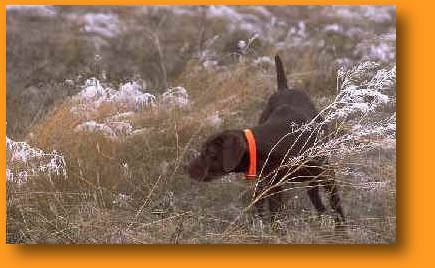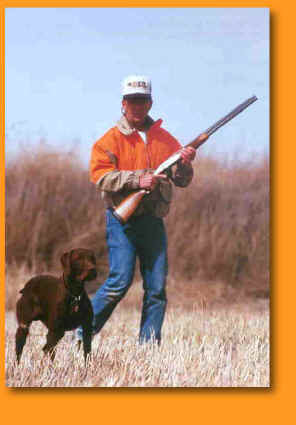A combination of pointers and poodles genetically make up the Pudelpointer, which was created in the late 1800's by Baron Von Zedlitz. He started with 90 "pointers" and 7 "poodles." Some who have studied the breed espouse his use of the modern Poodle; however, others feel the breeds forbears were actually Barbets; ancestors of the Wasser Poodle(water poodle). Nevertheless, the Pudelpointer inherited the intelligence, human attachment, obedience to owner, love of water, and natural retrieving abilities demonstrated by Poodles in the 1800's. The pointers contributed other hunting skills, including the sensitive nose and fiery attitude towards game. Credit for development of the Poodle is usually given to the French. However, some argue for it's origin to have been Germany. The German spelling of the breed is Pudel. Thus comes the spelling as we know now - Pudelpointer. The first cross of the Pudel and an English Pointer to establish the new breed took place in Germany in 1881. The sire was "Tell", an English Pointer belonging to Kaiser Frederick III, the dam was a German Hunting Pudel bitch "Molly", owned by Hegewald, a famous Teutonic author on the subject of hunting dogs. The idea behind this breeding was to combine the outstanding natural working abilities of the two great specialists in one dog: The intelligence, water love, retrieving instinct, easy trainability and willingness to please, wrapped into the protective coat of the Pudel with the unending desire to hunt, birdiness, pointing instinct, field nose and endurance of the English Pointer.The Pudelpointer in its home country Germany, has always ranked among the finest performers in tests and in the field, and is sought by those who enjoy and value a dog with desire and drive. While working on establishing the mental characteristics and the hunting attitude, the physical was slowly fixed. Today's Pudelpointer has a short, rough waterproof jacket with it's camouflage coloring and other qualities enabling the dogs to figure prominently in today's NAVHDA utility tests. Still, today in Germany the breed cannot achieve stud book status until the dog has passed demanding ability and utility testing. The dog must also pass a hip radiograph exam, as well as have a conformation rating. Today's Pudelpointers in North America have breeding restrictions very similar to those in Germany. North American Pudelpointers are registered with either American Field or NAVHDA. Hopefully the breed will never be registered with AKC and this breed will never be seen in an AKC show ring; breeding dogs for show quality has been the downfall for many sporting breeds as the show fanciers have little or no knowledge of hunting instincts necessary to maintain a breed such as the Pudelpointer for the hunting public. What is a Pudelpointer? The Pudelpointer is a medium sized dog with a height of 22-25 inches at the shoulder and weighing anywhere form 45 to 70 pounds. The color is usually a variant of liver; white markings on the chest and paws are permitted. The ideal Pudelpointer coat is harsh, wirey and dense but all kinds of variations are possible. Some specimens are almost smooth coated and others have a rather long and woolly coat, but all Pudelpointers should have pronounced eyebrows and whiskered muzzles. The tail is docked leaving approximately two-thirds of its original length. By nature the dog is friendly, inquisitive, eager to please, with a dash that makes it a pleasure to work with in the field and a cooperative attitude that also makes it a pleasure in the home. The Pudelpointer…. Firesides And Field
The men behind the selective breeding program that has produced the Pudelpointer of today have always had a dual target…a dog that could do them proud in the field and in the home. They have sought and found a dog that will hunt and point upland game with style, trail wounded birds, retrieve from land or water, and also be unobtrusive fireside companions and watchdogs. The whiskery brown dogs with the sparkling eyes usually show exceptional ability int the field. In a 1986 article, written by Dave Duffey in GUN DOG MAGAZINE, this preeminence is recognized. He says, "…of all the versatile breeds, the Pudelpointer impresses me as coming closest to the drive, application, intensity, range, and stamina of a good pointer in the uplands. They move better, hunt with more verse and purpose, and have a more independent bent than the other versatiles…" Pudelpointers as a rule are excellent water dogs. They do not quite match the retrievers marking ability but when it comes to working in a difficult marsh in search of downed waterfowl, they are the equal of the water specialist. As Dave Duffey says in his article, "Rare, But Proven", "You can expect a Pudelpointer to be intelligent and highly trainable. As with other German breeds, the Pudelpointer thrives on work and discipline and are capable of learning at the highest level." Also, while writing for FIELD &STRAM MAGAZINE, Bill Tarrent writes, "I love the pudelpointer too. Loved it since the first day I saw one work. They are a gay dog with heart warming ways, and most important, they are experts at getting mixed game into your gamebag." There are, also, several articles on our Magazine Articles page of this site that give more detailed information of the breed and it's past and present status as a versatile breed of sporting dog. |

